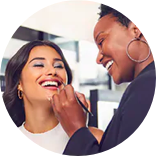Makeup - The fun part! Make is completely subjective and the only right way to do it is the way that looks right to you. If you feel happy with it, that’s all that matters. To make the experience more pleasant on the face, use makeup meant for your skin type. Something meant for oily skin will feel very drying on someone with dry skin since the makeup is formulated with ingredients that absorb moisture/oil or prevent oil from being produced. With all makeup, less is more. Use less than you think you need for any part of your face. You can always build up if you want more colour but it’s impossible to lighten or lessen without removing and starting over.
Foundation - The base for most of your makeup. This is one that should be purchased in store to correctly identify the right shade. It should blend seamlessly into your skin and look almost invisible. If you shop at Sephora, ask for a colour IQ or some advisors can shade match you themselves using their skills as makeup artists. Sheer coverage is a light wash of colour that can help even out your skin tone but still shows off your natural skin. Full coverage is almost completely opaque and will cover up most of your natural skin. Medium coverage is somewhere in the middle.
Concealer - It’s purpose is to cover up blemishes. Can be used under or over foundation and depends on what you’re trying to cover and the final effect you want. This should also be purchased in store to find the appropriate shade. It can also be used to brighten certain areas to make it look more youthful or awake. If you want this effect, get a concealer that is a shade or two lighter than your skin tone.
Blush - Everyone has some natural colour in their cheeks. This helps add that colour back in after covering it up with foundation. If you want it too look natural, have a look at your own bare skin and find a blush that’s similar. Of course, you can completely ignore that and have fun with the colour too! There’s not rule saying you can’t.
Eyeliner - This one takes practice but has a big payoff once you master it. It helps define your eyes and can be worn alone without eyeshadow. Black is a very bold choice but also very unforgiving. Brown looks softer and is more forgiving if you make a mistake. A pencil that you sharpen is usually the easiest type to use but there are gels, felt-tips, and brush-tips too. My personal preference is a felt or brush tip for more precision.
Mascara - Helps lengthen your lashes to also help accentuate your eyes. They come in lengthening formulas, volumizing formulas, or some combination. Usually they come in black, but you can get brown or even other fun colours are becoming trendy right now. A trick for mascara: if you get some on your eyelid or face, just left it dry. Once it’s dried up, brush it off with a cotton swab or stiff brush.
Eyeshadow - Not really necessary for your first go at make up but if you want to try, an easy place to start is a nude or brown palette. I would say start with a trio or a quad (3 or 4 different shades) and work your way up. These shades are more forgiving since they don’t deviate too far from your skin tone and will blend in with your skin easier. More shades can get overwhelming as to what to use and where. You can always branch out and add to it once you’ve gotten a good handle on the technique.
Lips - There are so many formulas to try! Matte finishes can be drying, so be aware of your skin type. The easiest place to start is a “my lips but better” (MLBB) shade. It’s a shade that closely matches your own lip colour and just enhances what you have. Again, screw the rules if you want and go for whatever colour you like. The bolder the colour, the less forgiving it is if you make a mistake, so it’s good to practice with something closer to your natural lip colour.














